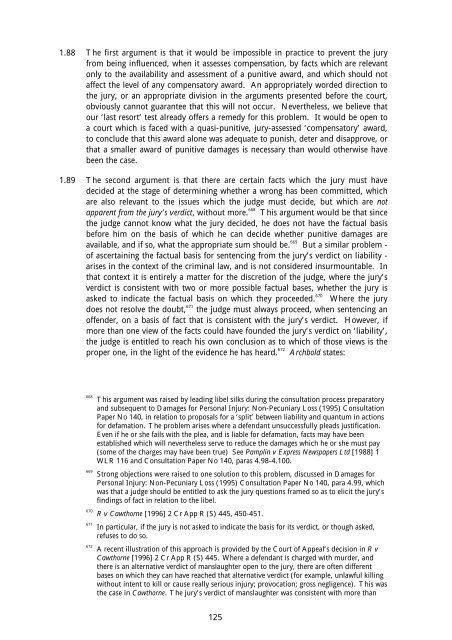Aggravated, Exemplary and Restitutionary ... - Law Commission
Aggravated, Exemplary and Restitutionary ... - Law Commission
Aggravated, Exemplary and Restitutionary ... - Law Commission
Create successful ePaper yourself
Turn your PDF publications into a flip-book with our unique Google optimized e-Paper software.
1.88 The first argument is that it would be impossible in practice to prevent the jury<br />
from being influenced, when it assesses compensation, by facts which are relevant<br />
only to the availability <strong>and</strong> assessment of a punitive award, <strong>and</strong> which should not<br />
affect the level of any compensatory award. An appropriately worded direction to<br />
the jury, or an appropriate division in the arguments presented before the court,<br />
obviously cannot guarantee that this will not occur. Nevertheless, we believe that<br />
our ‘last resort’ test already offers a remedy for this problem. It would be open to<br />
a court which is faced with a quasi-punitive, jury-assessed ‘compensatory’ award,<br />
to conclude that this award alone was adequate to punish, deter <strong>and</strong> disapprove, or<br />
that a smaller award of punitive damages is necessary than would otherwise have<br />
been the case.<br />
1.89 The second argument is that there are certain facts which the jury must have<br />
decided at the stage of determining whether a wrong has been committed, which<br />
are also relevant to the issues which the judge must decide, but which are not<br />
apparent from the jury’s verdict, without more. 668<br />
This argument would be that since<br />
the judge cannot know what the jury decided, he does not have the factual basis<br />
before him on the basis of which he can decide whether punitive damages are<br />
available, <strong>and</strong> if so, what the appropriate sum should be. 669<br />
But a similar problem -<br />
of ascertaining the factual basis for sentencing from the jury’s verdict on liability -<br />
arises in the context of the criminal law, <strong>and</strong> is not considered insurmountable. In<br />
that context it is entirely a matter for the discretion of the judge, where the jury’s<br />
verdict is consistent with two or more possible factual bases, whether the jury is<br />
asked to indicate the factual basis on which they proceeded. 670<br />
Where the jury<br />
does not resolve the doubt, 671<br />
the judge must always proceed, when sentencing an<br />
offender, on a basis of fact that is consistent with the jury’s verdict. However, if<br />
more than one view of the facts could have founded the jury’s verdict on ‘liability’,<br />
the judge is entitled to reach his own conclusion as to which of those views is the<br />
proper one, in the light of the evidence he has heard. 672<br />
Archbold states:<br />
668 This argument was raised by leading libel silks during the consultation process preparatory<br />
<strong>and</strong> subsequent to Damages for Personal Injury: Non-Pecuniary Loss (1995) Consultation<br />
Paper No 140, in relation to proposals for a ‘split’ between liability <strong>and</strong> quantum in actions<br />
for defamation. The problem arises where a defendant unsuccessfully pleads justification.<br />
Even if he or she fails with the plea, <strong>and</strong> is liable for defamation, facts may have been<br />
established which will nevertheless serve to reduce the damages which he or she must pay<br />
(some of the charges may have been true) See Pamplin v Express Newspapers Ltd [1988] 1<br />
WLR 116 <strong>and</strong> Consultation Paper No 140, paras 4.98-4.100.<br />
669 Strong objections were raised to one solution to this problem, discussed in Damages for<br />
Personal Injury: Non-Pecuniary Loss (1995) Consultation Paper No 140, para 4.99, which<br />
was that a judge should be entitled to ask the jury questions framed so as to elicit the jury’s<br />
findings of fact in relation to the libel.<br />
670 R v Cawthorne [1996] 2 Cr App R (S) 445, 450-451.<br />
671 In particular, if the jury is not asked to indicate the basis for its verdict, or though asked,<br />
refuses to do so.<br />
672 A recent illustration of this approach is provided by the Court of Appeal’s decision in R v<br />
Cawthorne [1996] 2 Cr App R (S) 445. Where a defendant is charged with murder, <strong>and</strong><br />
there is an alternative verdict of manslaughter open to the jury, there are often different<br />
bases on which they can have reached that alternative verdict (for example, unlawful killing<br />
without intent to kill or cause really serious injury; provocation; gross negligence). This was<br />
the case in Cawthorne. The jury’s verdict of manslaughter was consistent with more than<br />
125
















